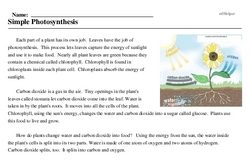Simple Photosynthesis
Each part of a plant has its own job. Leaves have the job of photosynthesis. This process lets leaves capture the energy of sunlight and use it to make food. Nearly all plant leaves are green because they contain a chemical called chlorophyll. Chlorophyll is found in chloroplasts inside each plant cell. Chloroplasts absorb the energy of sunlight.
Carbon dioxide is a gas in the air. Tiny openings in the plant's leaves called stomata let carbon dioxide come into the leaf. Water is taken in by the plant's roots. It moves into all the cells of the plant. Chlorophyll, using the sun's energy, changes the water and carbon dioxide into a sugar called glucose. Plants use this food to live and grow.
How do plants change water and carbon dioxide into food? Using the energy from the sun, the water inside the plant's cells is split into its two parts. Water is made of one atom of oxygen and two atoms of hydrogen. Carbon dioxide splits, too. It splits into carbon and oxygen.




